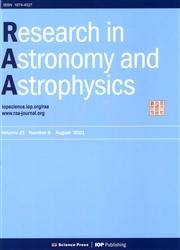Research on Pulsar Time Steered Atomic Time Algorithm Based on DPLL
IF 2.8
4区 物理与天体物理
Q3 ASTRONOMY & ASTROPHYSICS
引用次数: 0
Abstract
In today's society, there is a wide demand for high-precision and high-stability time service in the fields of electric power, communication, transportation and finance. At present, the time standard in various countries is mainly based on atomic clocks, but the frequency drift of atomic clocks will affect the long-term stability performance. Compared with atomic clocks, millisecond pulsars have better long-term stability and can complement with the excellent short-term stability of atomic clocks. In order to improve the long-term stability of the atomic time scale, and then improve the timing accuracy, this paper proposes an algorithm for steering the Atomic clock ensemble (ACE) by Ensemble pulsar time (EPT) based on Digital phase locked loop (DPLL). Firstly, the ACE and EPT are generated by ALGOS algorithm, then the ACE is steered by EPT based on DPLL to calibrate the long-term frequency drift of the atomic clock, so that the generated steered atomic time follows both the short-term stability characteristics of ACE and the long-term stability characteristics of EPT, and finally, the steered atomic time is used to calibrate the local cesium clock. The experimental results show that the long-term stability of atomic time after steering is improved by 2 orders of magnitude compared with that before steering, and the daily drift of local cesium clock after calibration is less than 9.47ns in 3 years, 3 orders of magnitude higher than that before calibration on accuracy.基于 DPLL 的脉冲星时间引导原子时算法研究
当今社会,电力、通信、交通、金融等领域对高精度、高稳定性的时间服务有着广泛的需求。目前,各国的时间标准主要基于原子钟,但原子钟的频率漂移会影响其长期稳定性能。与原子钟相比,毫秒脉冲星具有更好的长期稳定性,可以与原子钟出色的短期稳定性形成互补。为了提高原子时标的长期稳定性,进而提高授时精度,本文提出了一种基于数字锁相环(DPLL)的原子钟合集(ACE)与脉冲星合集时间(EPT)转向算法。首先通过 ALGOS 算法生成原子钟组(ACE)和脉冲星时间(EPT),然后通过基于 DPLL 的脉冲星时间(EPT)对原子钟组(ACE)进行转向,以校准原子钟的长期频率漂移,从而使生成的转向原子时既遵循原子钟组(ACE)的短期稳定特性,又遵循脉冲星时间(EPT)的长期稳定特性,最后利用转向原子时校准本地铯钟。实验结果表明,转向后的原子时的长期稳定性比转向前提高了 2 个数量级,校准后的本地铯钟在 3 年内的日漂移小于 9.47ns,在精度上比校准前提高了 3 个数量级。
本文章由计算机程序翻译,如有差异,请以英文原文为准。
求助全文
约1分钟内获得全文
求助全文
来源期刊

Research in Astronomy and Astrophysics
地学天文-天文与天体物理
CiteScore
3.20
自引率
16.70%
发文量
2599
审稿时长
6.0 months
期刊介绍:
Research in Astronomy and Astrophysics (RAA) is an international journal publishing original research papers and reviews across all branches of astronomy and astrophysics, with a particular interest in the following topics:
-large-scale structure of universe formation and evolution of galaxies-
high-energy and cataclysmic processes in astrophysics-
formation and evolution of stars-
astrogeodynamics-
solar magnetic activity and heliogeospace environments-
dynamics of celestial bodies in the solar system and artificial bodies-
space observation and exploration-
new astronomical techniques and methods
 求助内容:
求助内容: 应助结果提醒方式:
应助结果提醒方式:


